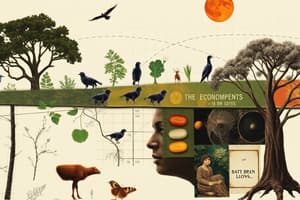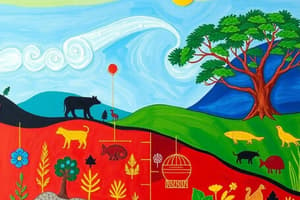Podcast
Questions and Answers
What defines an ecosystem?
What defines an ecosystem?
- The interaction of living organisms with each other only
- A system that operates independently from its environment
- The collection of abiotic elements without living organisms
- The interaction between organisms and the surrounding environment (correct)
What are the two main components that make up an ecosystem's structure?
What are the two main components that make up an ecosystem's structure?
- Atmosphere and biosphere
- Primary and secondary consumers
- Producers and consumers
- Biotic and abiotic components (correct)
What is a producer in an ecosystem?
What is a producer in an ecosystem?
- An organism that decomposes organic material
- An organism that feeds on other organisms
- An organism that is at the top of the food chain
- An organism that creates energy from sunlight (correct)
What is the correct sequence of energy flow in a food chain?
What is the correct sequence of energy flow in a food chain?
Which of the following roles does a decomposer play in an ecosystem?
Which of the following roles does a decomposer play in an ecosystem?
Which statement best describes the term 'niche' in ecology?
Which statement best describes the term 'niche' in ecology?
What is one way energy is lost within an ecosystem?
What is one way energy is lost within an ecosystem?
Which of the following is considered an abiotic component of an ecosystem?
Which of the following is considered an abiotic component of an ecosystem?
What role do primary consumers play in the food chain?
What role do primary consumers play in the food chain?
What is an example of a tertiary consumer in a typical food chain?
What is an example of a tertiary consumer in a typical food chain?
Flashcards
Ecosystem
Ecosystem
An ecosystem is a unit in ecology where living organisms interact with each other and their environment.
Structure of an Ecosystem
Structure of an Ecosystem
The structure of an ecosystem is how biotic (living) and abiotic (non-living) components are organized.
Food Chain
Food Chain
The flow of energy from producers to consumers to decomposers.
Biotic Components
Biotic Components
Signup and view all the flashcards
Abiotic Components
Abiotic Components
Signup and view all the flashcards
Producers
Producers
Signup and view all the flashcards
Consumers
Consumers
Signup and view all the flashcards
Decomposers
Decomposers
Signup and view all the flashcards
Niche
Niche
Signup and view all the flashcards
Food Chain Example
Food Chain Example
Signup and view all the flashcards
Study Notes
Ecosystems
- An ecosystem is the structural and functional unit of ecology.
- Organisms in an ecosystem interact with each other and their environment.
- Ecosystems consist of interactions between organisms and their environment.
Ecosystem Structure
- Ecosystems are characterized by biotic and abiotic components.
- Biotic components are living organisms.
- Abiotic components are non-living factors, like climate.
- Energy flows through ecosystems from a producer to a consumer, to an apex predator, or a detritivore.
Food Chains
- Energy is converted from light energy to chemical energy.
- Energy flows through ecosystems through successive levels.
- The flow of energy from a producer to a consumer to an apex predator or detritivore is called a food chain. This process is part of biological processes.
- Examples shown: Grasshoppers eat grass, mice eat grasshoppers, snakes eat mice, eagles eat snakes. Fungi break organisms down at the end of the chain, recycling nutrients to help the grass grow.
Ecosystem Hierarchy
- Ecosystems include biotic (living) and abiotic (non-living) factors.
- Biotic components include producers, consumers (primary, secondary, tertiary), and decomposers.
- Decomposers break down organic matter.
Niche
- In ecology, a niche describes an organism's role within a community.
Studying That Suits You
Use AI to generate personalized quizzes and flashcards to suit your learning preferences.




